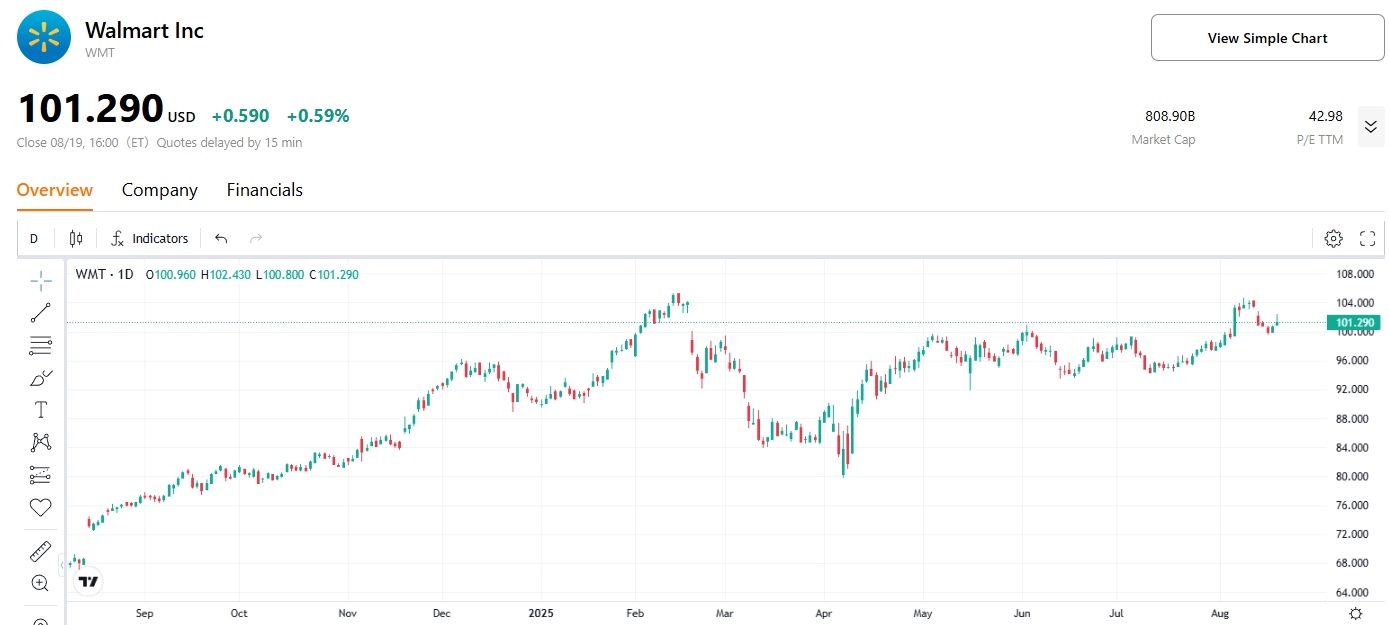Two Key Things to Watch in Walmart’s Q2 Earnings: Tariff Pressure and E-Commerce Momentum
TradingKey - U.S. retailer Walmart (WMT) will release its Q2 2026 fiscal earnings before the market opens on August 21. As a key barometer of the U.S. economy and consumer health, Walmart’s results will reveal how tariffs are impacting consumer behavior and corporate profits. Another focus is whether its e-commerce business, which recently achieved a milestone, can maintain its strong momentum.
Analysts expect:
- Q2 revenue: $174.11 billion, up 4% year-over-year
- EPS: $0.73, up 9% YoY
How Big Is the Tariff Impact?
One of the most important aspects of Walmart’s Q2 performance will be how tariffs are affecting consumer behavior and company profits.
Walmart’s CFO noted that the current pace and scale of price increases are unprecedented, and the significant rise in tariffs has created a challenging operating environment, making it difficult for retailers to absorb all cost increases.
Walmart CEO Doug McMillon said during the Q1 earnings call that given the scale of tariffs, even with reduced tariff rates and efforts to keep prices low, Walmart may not be able to absorb all the pressure due to the thin profit margins typical in retail.
Walmart previously warned that price increases due to tariffs could begin in May. According to a CNBC survey, between May and July, over a dozen of the more than 50 products surveyed showed clear price increases — some kitchenware sets rose as much as 50%, and coffee prices increased 9% to 17%.
As recent CPI reports have shown, analysts believe inventory management has buffered price increases so far. But as inventories are depleted, the extent of further price hikes will depend on how much of the cost is passed on to end consumers.
TradingKey analyst Mario Ma said that if consumer behavior shifts — such as a continued move toward lower-priced goods or reduced spending on non-essentials — Walmart’s same-store sales growth could fall short, dragging overall revenue below expectations. He recommends closely watching same-store sales growth in grocery and essentials departments.
Walmart previously forecast net sales growth of 3.5% to 4.5% for Q2 but did not provide EPS guidance due to potential tariff volatility. Wall Street expects:
- U.S. net sales growth of 4% YoY
- U.S. comparable sales growth to slow from 4.5% in Q1 to 4%
Bank of America analyst Robert Ohmes said that although the uncertain environment prevented Walmart from issuing profit guidance, the company’s ability to manage tariffs through its scale, pricing strategy, and inventory control remains a significant advantage.
Will E-commerce Shine Again?
In Q1, Walmart’s e-commerce division reached a major milestone — its U.S. and global e-commerce operations achieved quarterly profitability for the first time. Investors are watching whether this digital transformation momentum can continue in Q2.
E-commerce revenue primarily comes from online product sales, Connect advertising, and membership fees. In Q1:
- U.S. e-commerce sales grew 21%, marking 12 consecutive quarters of double-digit growth
- Global e-commerce sales rose 22%
A June report from Morgan Stanley noted that Walmart’s transformation into a digital retail leader is reshaping its profit trajectory. Thanks to economies of scale, increased regional density, and growth in high-margin membership and advertising revenue, e-commerce losses have narrowed to near break-even.
Bank of America said that growth in affiliate businesses and market expansion will further strengthen the long-term profitability of Walmart’s digital advertising and e-commerce segments. While the current valuation is high, it is supported by Walmart’s continued market share gains across product categories and customer segments — especially among higher-income consumers.
As of writing, Walmart’s stock is near its all-time high, up 12% year-to-date in 2025, slightly outperforming the S&P 500’s 9% gain. According to TradingKey, the average analyst target price for Walmart is $111.20, implying about 10% upside from current levels.

Walmart Stock Price in 2025, Source: TradingKey
Ahead of the earnings release, Guggenheim raised its price target for Walmart from $112 to $115, maintaining a Buy rating. Evercore raised its target from $108 to $110, keeping an Outperform rating.



